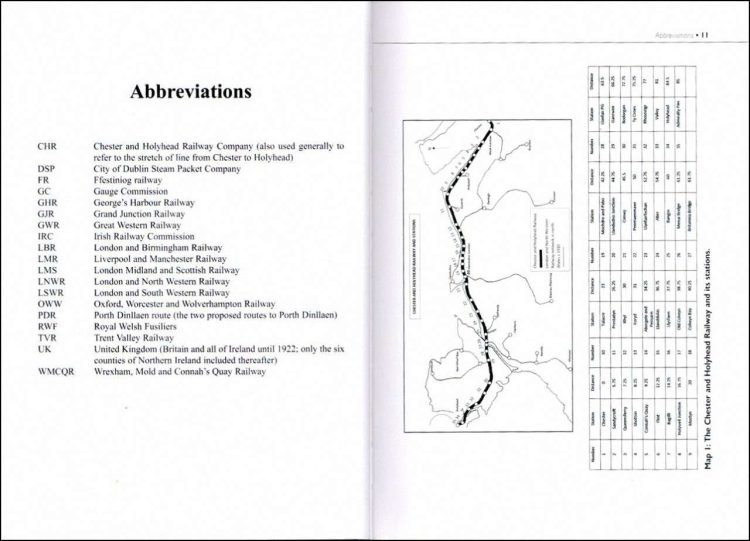Published in November 2021 by Pen & Sword and written by Philip M Lloyd, this hardback book measures around 24.8 cm x 17.8 cm, is 280 pages long and has 100 black and white illustrations and maps. It has a published price of £30, and at the time of writing it can be purchased online from Pen & Sword for a 10% discount and from Amazon for around £23.50.
This book has ten chapters, a section listing Abbreviations, and two appendices. For some reason, included in the Abbreviations section is a map of the route accompanied by a list detailing the opening dates of each station and its distance from the previous station.
Rather annoyingly, the map and accompanying text are printed in landscape format, whereas there is more than enough space to have produced it in portrait format as per the rest of the book.

There have been three previous books about the Chester to Holyhead railway line: The Chester and Holyhead Railway by J.M. Dunn and published by the Oakwood Press in 1948; The Chester and Holyhead Railway by Peter Baughan and published by David and Charles in 1972, and An Historical Survey of the Chester to Holyhead Railway, track layouts and illustrations by V.R. Anderson and G.K. Fox and published by the Oxford Publishing Company in 1984. This book adds to the information in those books, and the author wrote it as his Doctorate in Railway Studies at York University.
The book begins by looking at a GWR proposal for a route that would link London to a port at Porth Dinllaen near Pwllheli, via Worcester, Ludlow, and Newtown. However, the final chapter concludes that the Chester to Holyhead route was conceived more as a political choice than its practicality. In between, we find that there was also an alternative proposal to use Llandudno as the departure point for Ireland, as there had been government concern about high shipping losses in the Irish Sea and the need for better harbour facilities than Holyhead could accommodate.
The author focuses on the people involved in building and running the railway and the impact the railway had on both them and the wider population. He provides a thorough overview of the impact on North Wales of the Chester to Holyhead line and its key role in the area's development. The book will be of special value to those with an interest in the history of railway development in the area.
Following a chapter on accidents, there are sections on the link with Ireland, the Irish conflict, tourism, and the people of North Wales. It concludes with a look at the line's rapid decline, linked to deindustrialisation, and its slow recovery.
The author also identifies new threats, in particular, climate change and the potential dangers the line faces from rising sea levels, given the line's route along the North Wales coast. There is also a fascinating appendix where every mile of the line is linked to an incident or photograph from the book.
We also find that Welsh nationalisation came into play with the LNWR's ill-timed decision to sack employees. MPs were finding that they had to pay more attention to their constituents who were no longer just the landed gentry, but a larger number of middle-class householders.
The book is mostly text but with a good range of well produced illustrations.
The book concludes with two appendices which, like the map at the beginning, have been printed in landscape format. Surely the map with its table and the Appendix of opening and closing dates could have been incorporated.
Appendix 2 is especially interesting as it lists every mile along the line that is linked to an incident mentioned or photograph shown in the book, but it also suffers from being printed in landscape format, whereas with a better choice of font it would have been ideally presented in portrait mode.
Unfortunately, the quality of many of the photographs do not come up to the standards set by the text.
Avanti West Coast Voyagers must have been a mere pipe dream when plans for the railway were first made.
The chapter is titled “The Railway and the People of North Wales”, and the photographs here bear that out.
The page on the right leaves us in no doubt that we are in North Wales.
Although bordered by the sea on one side and Snowdonia on the other, parts of the line cannot be considered picturesque.
In summary, although mostly text, there are a good range of illustrations with very informative captions. The author provides a balanced view on the conflicting requirements between managing the railway as a facility for transporting newspapers between the UK and Ireland, and how it could be profitable to engage with the businesses and community on the Welsh coast, including the growth of tourism from the 1850s through to the 1960s before the mass defection to road. The book provides a thorough overview of the line and its key role in the area's development and will be of special value to those with an interest in the history of railway development in the area.
The book is available to purchase from Amazon and from Pen & Sword.
We would like to thank Pen & Sword for providing RailAdvent with a copy of the book for review.